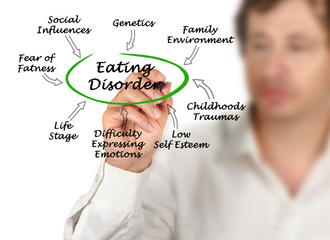Written by: Jessica Hansford LPC, CAAD

Eating disorders and substance use are serious enough on their own but present specific challenges when they occur together. In this post, we look at how and when they overlap, and examine four best practices for treatment.
The past couple of years, the whole country has been under a new level of stress and there has been a significant increase in needed support for a variety of mental health issues.
Both substance use disorders and eating disorders have been areas of increasing concern for a number of Americans. While these may seem like separate areas of struggle, it is important to note that these disorders frequently occur together.
In fact, according to the National Eating Disorders Association (NEDA), up to 50% of individuals with eating disorders abused alcohol or illicit drugs, which is 5 times higher than the regular population. In addition, research shows that people who suffer from substance use disorders are ten times more likely to have an eating disorder than the general population.
Why Eating Disorders and Substance Use Can Overlap
The presence of both a substance use disorder and eating disorder symptoms is known as a co-occurring disorder (more than one mental health diagnosis occurring at the same time).
There are often overlapping risk factors such as genetics, changes in the brain’s reward system and personality traits such as achievement expectations, difficulty with emotional regulation, and a history of trauma or environmental/social pressures. Sometimes eating disorders and substance use disorders appear at the same time, serving as methods of coping with stressful emotional situations.
In other cases, substance use disorders can occur during or after recovery from an eating disorder as a person sets down one coping skill for another, a phenomenon known in the therapeutic community as symptom substitution. This can lead to a dangerous and frustrating process of “whack-a-mole” treatment – effectively addressing substance use symptoms only to see an increase in eating disorder behaviors and vice versa.
4 Best Practices for Treating Both
Due to this documented struggle, it is important for those facing an overlap of these two concerns to be aware of best practices for treatment.
1. Assess the Safety of the Individual
The physical safety of the individual needs to be prioritized and assessed first to determine the most appropriate treatment plan. It is essential to assess whether supportive medical care or hospitalization is indicated due to the disordered eating behaviors or substance use. For example, it is possible the individual may require a medical detoxification program with ongoing monitoring to withdraw from certain substances safely and comfortably, such as alcohol or benzodiazepines. This type of assessment might occur by a medical or mental health professional during an initial intake screening or bio-psycho-social assessment. The assessor would inquire about the types and quantity of substances used, length of usage, age, gender, and medical history. Medical labs and an EKG are generally recommended, as well.
When assessing the severity of disordered eating, immediate medical attention and monitoring might be needed if someone is purging multiple times a day, severely restricting fluids, at a very low weight and/or experiencing physical symptoms such as fainting, dizziness upon standing, or low heart rate.
The risk of suicidality is elevated for those with eating disorders and substance use disorders, as well. If suicidality is present, inpatient monitoring may be necessary depending on your client’s level of risk. To assess for suicidality, the Columbia Suicide Severity Rating Scale (C-SSRS) is a short, evidenced based screening tool that can be used in a variety of different settings to assess the severity of suicidal ideation and behavior in children, adolescents, and adults. You do not need any prior mental health training or experience to ask the questions in the C-SSRS.
- To download an existing version of the C-SSRS click here.
- Although training is not required, it can be helpful. Free training can be found here.
2. Evaluate Treatment Needs
Once a screening has been done to determine if immediate medical intervention or monitoring is necessary to ensure safety, the next step is to appropriately match the recommended level of care to the individual’s medical, nutritional, and psychological needs. When diagnosing a substance use or eating disorder and determining the best therapeutic intervention, the clinician will evaluate level of distress, frequency, and duration of symptoms, as well as the client’s level of motivation, support from others, and environmental stress.
Treatment for these disorders range from an outpatient interdisciplinary team to residential or more medically based inpatient care. Although it is imperative to not undertreat a client’s needs, research shows it is also critical not to overtreat; therefore, it is important to seek out an evidenced-based therapeutic assessment to ensure the care provided best meets the identified needs within the least restrictive treatment setting.
3. Determine If Concurrent Treatment is Necessary
One of the most important elements to consider when addressing substance use and eating disorders is the need for concurrent treatment. Effective dual diagnosis programs have an appreciation for potential risk of relapse and the need for a potentially longer and more comprehensive treatment approach. The interaction between substance use disorders and eating disorders is complex and treatment should be highly individualized. Substances may be used or abused to cope with the eating disorder, such as using substances to increase appetite. Alternatively, substances may be used in service to the eating disorder such as using substances to purge, decrease appetite or escape intrusive thoughts, intense urges, and distressing feelings.
4. Decide on a Treatment Track
A person’s choice of substances is often connected to the distressing emotional state they are trying to manage. This can lead to a cycle that is difficult to break. The eating disorder symptoms can lead to an increase in substance use which can potentially result in ongoing worsening of both diagnoses. Best practice intervention includes treatment with cross-trained staff and integrated supportive care. Beyond the interruption of symptoms, these programs need to address other co-occurring diagnoses and underlying issues such as PTSD/trauma, anxiety/depression, relational/interpersonal factors, developmental factors, and neurobiological factors. A quality co-occurring treatment program will work to increase understanding of the connection between substance use, eating disorder behaviors, comorbid diagnoses, and current functioning/quality of life.
Addressing this complicated collection of symptoms will require work to enhance motivation to change, identify core values, tolerate, and regulate emotions, develop, and maintain healthy relationships, and strengthen relapse prevention skills.
Conclusion
Support, hope, and healing are possible. If you or someone you know is considering seeking treatment for both substance use and eating disorder concerns, look for a co-occurring reputable and qualified professional or program to conduct a comprehensive assessment to identify any required medical intervention and to recommend the appropriate level of care.


